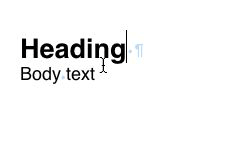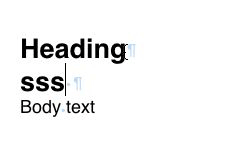Pages 3.0: Trailing space still causes ‘Following Paragraph Style’ option to fail
Posted by Pierre Igot in: PagesNovember 30th, 2007 • 9:30 am
A while ago, I reported on a problem in Pages 2.0 that would cause the “Following Paragraph Style” rule to fail.
The problem was with paragraphs that were styled with a formatting option instructing Pages to switch to another style for the following paragraph (this option, labelled “Following Paragraph Style,” is located in the text inspector, under “More”).
In Pages 2.0, if you had a paragraph formatted with this option, but if the paragraph had one or more trailing spaces at the end of it, and if the I-beam insertion point was before these trailing spaces, if you pressed Return then Pages would fail to switch to the style defined in the “Following Paragraph Style” option, and instead would insert a new paragraph in the same style as the current one.
Back in August 2007, a long-time Betalogue reader was kind enough to inform me in a comment on the blog post that the problem had been partly fixed in Pages 3.0.
And indeed I was able to confirm this myself:
Apple has partially fixed the problem with the “Following Paragraph Style” feature not working when you press Return before the very end of a paragraph, but they have only fixed it when there is a single trailing space character between the insertion point and the end of the paragraph. Anything else (like two spaces, or a non-breaking space), and the feature still fails miserably.
But I am now able to confirm that is even worse than what I initially thought. There is another situation where the style switching fails even if the current paragraph only has one trailing space. It is when there already is another paragraph after the current paragraph.
Consider the following situation:

As you can see, the current paragraph is in Heading style, has a trailing space (tiny blue dot after “Heading” text), and the insertion point is before that trailing space.
But this current paragraph also already has some text in another style immediately following it. Still, it shouldn’t make any difference, should it?
I am afraid it does. Look at what happens if I press Return now and type a few characters:

The newly inserted paragraph is in Heading style as well!
So this means that, following our bug reports, Apple’s engineers only bothered to fix the flaw in one very specific situation:
- The current paragraph is in a style with a “Following Paragraph Style” option requiring a switch to a different style for the next paragraph (after pressing return).
- The current paragraph has a trailing space consisting of a single regular character space (not two or more spaces, not a non-breaking space).
- The current paragraph is the very last paragraph in the document.
This really is quite remarkable. It makes you wonder why they bothered to fix the flaw at all. It really demonstrates a total lack of effort to try and take into account a variety of real-life scenarios. After all, people don’t write their documents in one fell swoop, in a continuous flow of text, with the insertion point always in the very last paragraph of the document. They write something, then they go back to edit what they have already written, adding or removing sentences, sometimes entire paragraphs.
It really is very disappointing on Apple’s part.
It means that I still encounter the problem with Pages refusing to switch to the specified following style when I want it to—unless I always make sure that I never have any trailing spaces anywhere. Which, of course, is rather unrealistic.
It’s time for Apple’s engineers to get a dose of reality and actually try to use Pages in their own word processing work. In the real world, trailing spaces do happen, and people do insert new paragraphs in the middle of their existing paragraphs. Duh.
December 1st, 2007 at Dec 01, 07 | 6:22 am
Am I missing something, or is Pages entirely missing any hierarchically-defined style abilities?
December 1st, 2007 at Dec 01, 07 | 10:28 am
Unfortunately, you’re not missing anything.